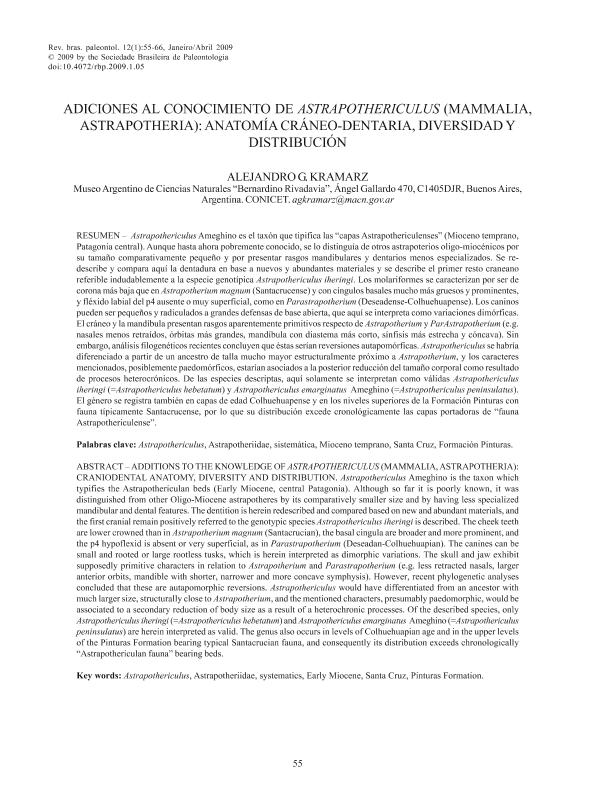Artículo
Astrapothericulus Ameghino es el taxón que tipifica las “capas Astrapothericulenses” (Mioceno temprano, Patagonia central). Aunque hasta ahora pobremente conocido, se lo distinguía de otros astrapoterios oligo-miocénicos por su tamaño comparativamente pequeño y por presentar rasgos mandibulares y dentarios menos especializados. Se redescribe y compara aquí la dentadura en base a nuevos y abundantes materiales y se describe el primer resto craneano referible indudablemente a la especie genotípica Astrapothericulus iheringi. Los molariformes se caracterizan por ser de corona más baja que en Astrapotherium magnum (Santacrucense) y con cíngulos basales mucho más gruesos y prominentes, y fléxido labial del p4 ausente o muy superficial, como en Parastrapotherium (Deseadense-Colhuehuapense). Los caninos pueden ser pequeños y radiculados a grandes defensas de base abierta, que aquí se interpreta como variaciones dimórficas. El cráneo y la mandíbula presentan rasgos aparentemente primitivos respecto de Astrapotherium y ParAstrapotherium (e.g. nasales menos retraídos, órbitas más grandes, mandíbula con diastema más corto, sínfisis más estrecha y cóncava). Sin embargo, análisis filogenéticos recientes concluyen que éstas serían reversiones autapomórficas. Astrapothericulus se habría diferenciado a partir de un ancestro de talla mucho mayor estructuralmente próximo a Astrapotherium, y los caracteres mencionados, posiblemente paedomórficos, estarían asociados a la posterior reducción del tamaño corporal como resultado de procesos heterocrónicos. De las especies descriptas, aquí solamente se interpretan como válidas Astrapothericulus iheringi (=Astrapothericulus hebetatum) y Astrapothericulus emarginatus Ameghino (=Astrapothericulus peninsulatus). El género se registra también en capas de edad Colhuehuapense y en los niveles superiores de la Formación Pinturas con fauna típicamente Santacrucense, por lo que su distribución excede cronológicamente las capas portadoras de “fauna Astrapothericulense”. Astrapothericulus Ameghino is the taxon which typifies the Astrapothericulan beds (Early Miocene, central Patagonia). Although so far it is poorly known, it was distinguished from other Oligo-Miocene astrapotheres by its comparatively smaller size and by having less specialized mandibular and dental features. The dentition is herein redescribed and compared based on new and abundant materials, and the first cranial remain positively referred to the genotypic species Astrapothericulus iheringi is described. The cheek teeth are lower crowned than in Astrapotherium magnum (Santacrucian), the basal cingula are broader and more prominent, and the p4 hypoflexid is absent or very superficial, as in Parastrapotherium (Deseadan-Colhuehuapian). The canines can be small and rooted or large rootless tusks, which is herein interpreted as dimorphic variations. The skull and jaw exhibit supposedly primitive characters in relation to Astrapotherium and Parastrapotherium (e.g. less retracted nasals, larger anterior orbits, mandible with shorter, narrower and more concave symphysis). However, recent phylogenetic analyses concluded that these are autapomorphic reversions. Astrapothericulus would have differentiated from an ancestor with much larger size, structurally close to Astrapotherium, and the mentioned characters, presumably paedomorphic, would be associated to a secondary reduction of body size as a result of a heterochronic processes. Of the described species, only Astrapothericulusiheringi (=Astrapothericulus hebetatum) and Astrapothericulus emarginatus Ameghino (=Astrapothericulus peninsulatus) are herein interpreted as valid. The genus also occurs in levels of Colhuehuapian age and in the upper levels of the Pinturas Formation bearing typical Santacrucian fauna, and consequently its distribution exceeds chronologically “Astrapothericulan fauna” bearing beds.
Adiciones al conocimiento de Astrapothericulus (Mammalia, Astrapotheria): anatomía cráneo-dentaria, diversidad y distribución
Título:
Additions to the knowledge of Astrapothericulus (Mammalia, Astrapotheria): craniodental anatomy, diversity and distribution
Fecha de publicación:
04/2009
Editorial:
Sociedade Brasileira de Paleontologia
Revista:
Revista Brasileira de Paleontologia
ISSN:
1519-7530
Idioma:
Español
Tipo de recurso:
Artículo publicado
Clasificación temática:
Resumen
Archivos asociados
Licencia
Identificadores
Colecciones
Articulos(MACNBR)
Articulos de MUSEO ARG.DE CS.NAT "BERNARDINO RIVADAVIA"
Articulos de MUSEO ARG.DE CS.NAT "BERNARDINO RIVADAVIA"
Citación
Kramarz, Alejandro Gustavo; Adiciones al conocimiento de Astrapothericulus (Mammalia, Astrapotheria): anatomía cráneo-dentaria, diversidad y distribución; Sociedade Brasileira de Paleontologia; Revista Brasileira de Paleontologia; 12; 1; 4-2009; 55-66
Compartir
Altmétricas




